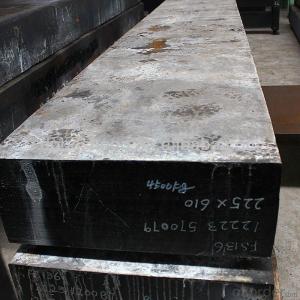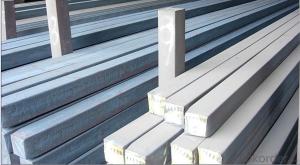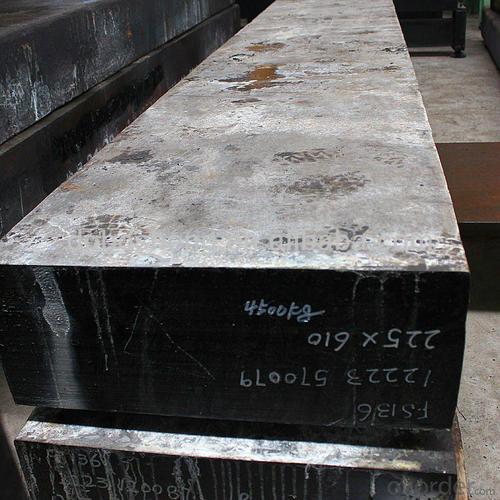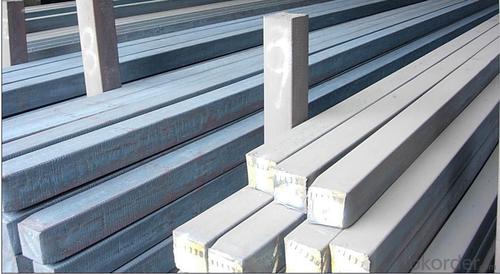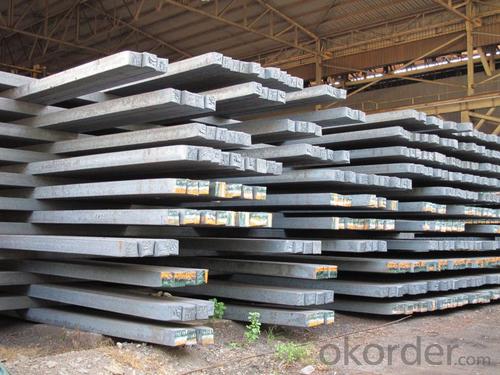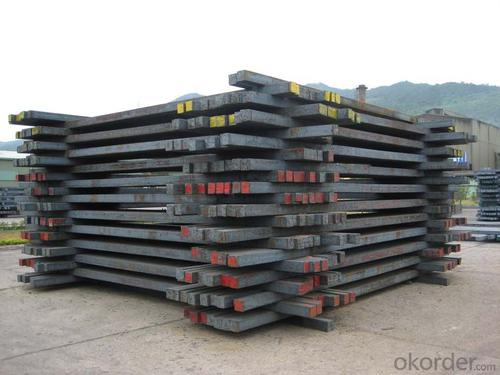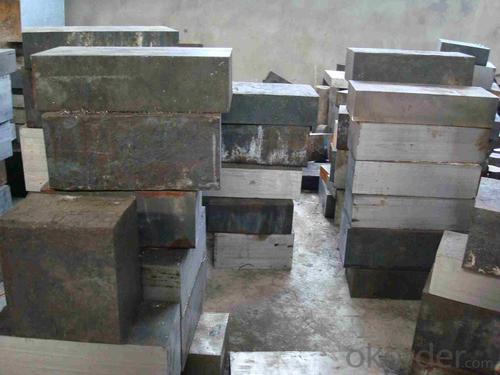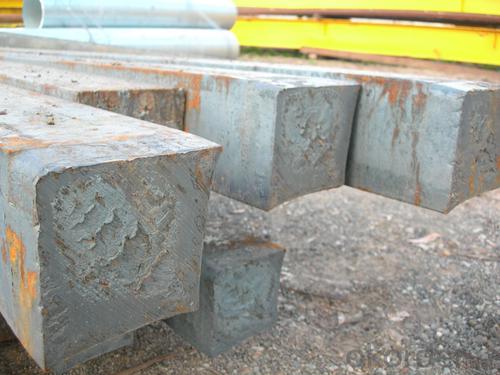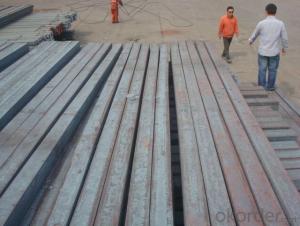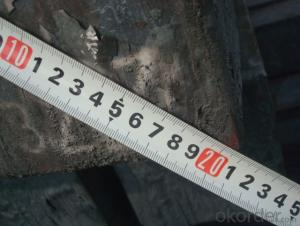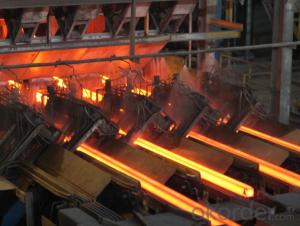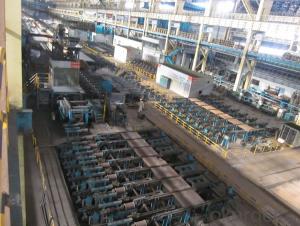Square Steel Billet Q235 Grade Prime Quality 6#
- Loading Port:
- Tianjin
- Payment Terms:
- TT OR LC
- Min Order Qty:
- 2000 m.t
- Supply Capability:
- 50000 m.t/month
OKorder Service Pledge
OKorder Financial Service
You Might Also Like
Description of Square Steel Billet Q235 Grade Prime Quality 6#
M. S. Billets are used for rolling of TMT Re-Bars of Fe415 and Fe500 Grade and various other structural steel products.
CRS Billets are used for rolling of CRS TMT Re-Bars.
Special Alloy Billets are used for rolling of any special grade TMT Re-Bars like Earthquake resistant TMT Re-Bars and for special grade structural steel products.
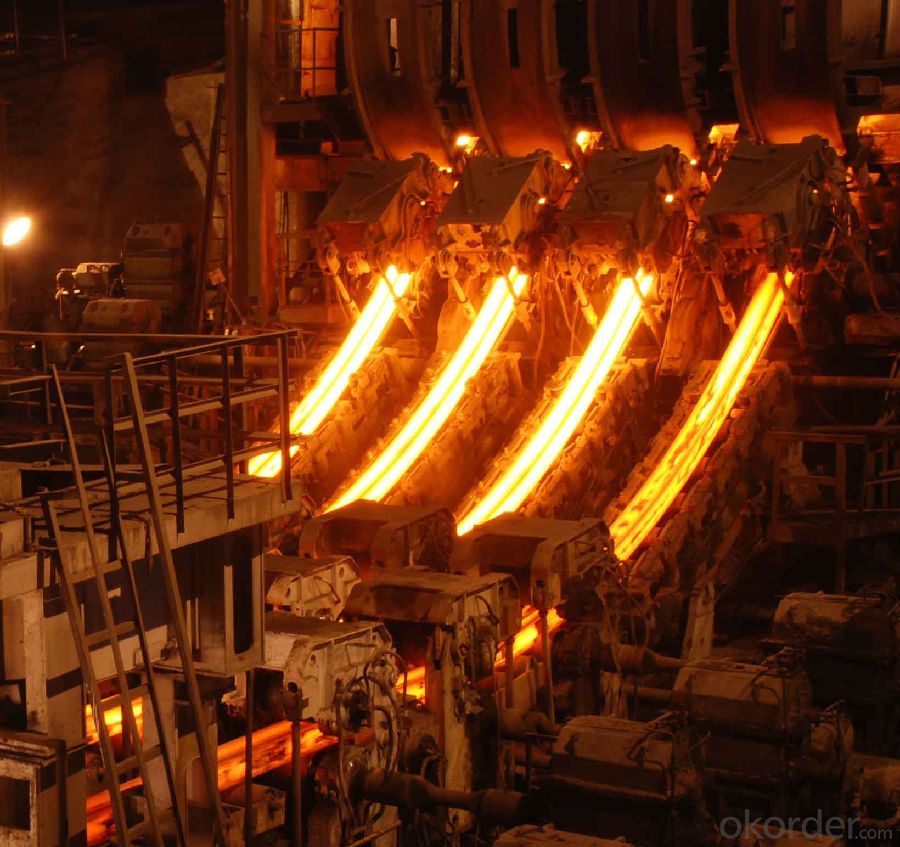
Main Feature Square Steel Billet Q235 Grade Prime Quality 6#
Raw elements(C,Fe,Ni,Mn,Cr,Cu.)---Smelted ingots by AOD finery---hot rolled into black suface---pickling in acid liquid---cold drawn----polished by automatically machine--- cutting into pieces---checking quanlity
Applications of Square Steel Billet Q235 Grade Prime Quality 6#
Widely Used in the areas such as Stainless Steel Fasteners, Chains, Kitchen and Sanitary wares, Furniture handles, Handrails, Electroplating and Electrolyzing pendants, Foods, Electron, Petroleum, Construction and Decoration, etc. Products have a high strength after cold-working. Electronic products parts, Medical appliance, Springs, Bus Inside and Outside packaging and building, Street Lamp Posts, etc. Decoration materials and Outdoor Publicity Billboard. Used for the products which have the Anti-Stress Corrosion requirement. Electron Products, Table-wares, Bolts, Nuts, Screen Meshes, Cumbustors and so on.
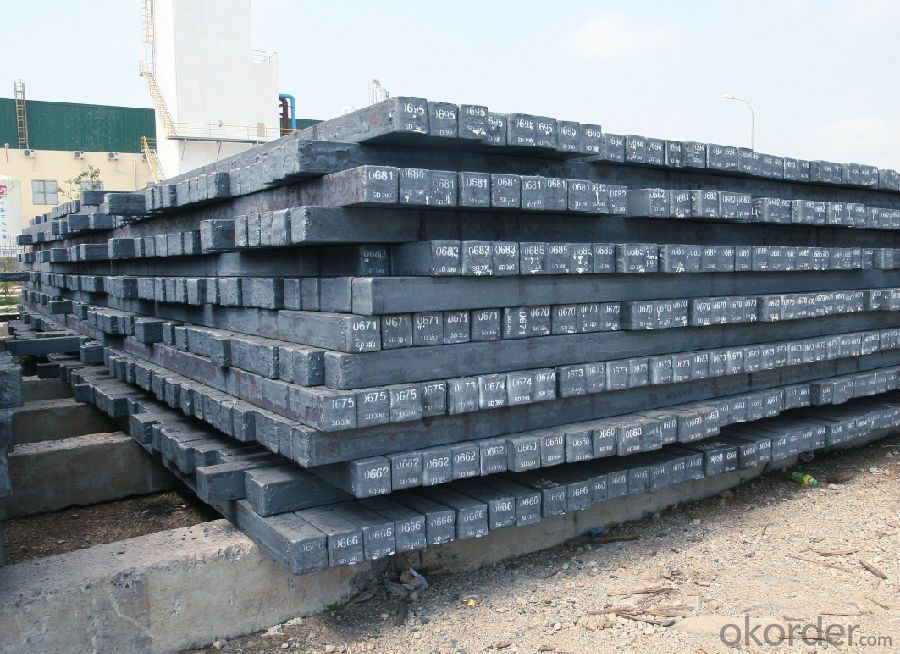
Specifications of Square Steel Billet Q235 Grade Prime Quality 6#
| Standard | C(%) | Mn(%) | S(%) | P(%) | Si(%) |
| Q195 | ≤0.12 | ≤0.50 | ≤0.040 | ≤0.035 | ≤0.30 |
| Q235 | ≤0.20 | ≤1.40 | ≤0.045 | ≤0.045 | ≤0.35 |
| Q275 | ≤0.22 | ≤1.50 | ≤0.045 | ≤0.045 | ≤0.35 |
| 20MnSi | 0.17-0.25 | 1.2-1.6 | ≤ 0.050 | ≤ 0.050 | 0.40-0.80 |
| 3SP | 0.14-0.22 | 0.40-0.85 | ≤ 0.050 | ≤ 0.040 | 0.05-0.15 |
| 5SP | 0.28-0.37 | 0.50-1.00 | ≤ 0.050 | ≤ 0.040 | 0.15-0.30 |
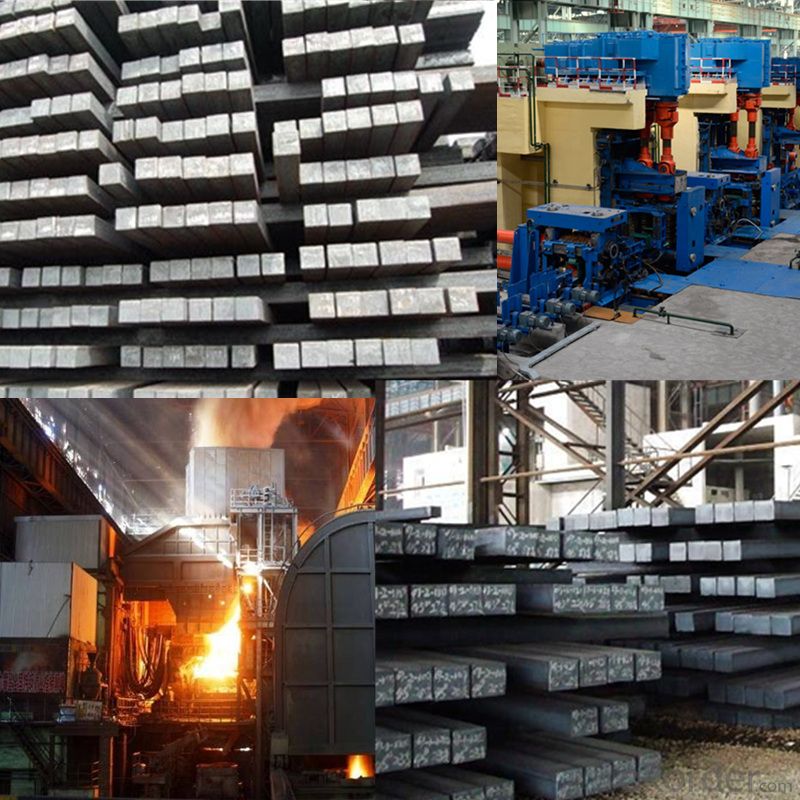
FAQ of Square Steel Billet Q235 Grade Prime Quality 6#
We have organized several common questions for our clients,may help you sincerely:
1. How Can I Visit There?
Our company is located in Tianjin City, China, near Beijing. You can fly to Tianjin Airport Directly. All our clients, from home or aboard, are warmly welcome to visit us!
2. How Can I Get Some Sample?
We are honored to offer you sample.
3. Why choose CNBM?
Our delivery time about 15-20days for standard sizes, if you have other requirements like hardness, quanity and width ,it is about 20-40days. But don't worry we also try our best for the delivery time ,because time longer and our cost is higher.
- Q: How to purchase suitable billet heating furnace
- Choice can not be blind, you can not just look at the price, the choice of advice you consult more manufacturers, and then use the exclusion method to determine your final goal. Online can take a look at live video, more reference.
- Q: Can steel billets be used in the production of construction machinery?
- Construction machinery can indeed be produced using steel billets. Steel billets, which are partially finished steel products, can be further processed into various shapes and sizes, including components for construction machinery. These billets can be hot-rolled or cold-rolled to create different types of steel products commonly used in construction, such as bars, rods, plates, or sheets. Steel's exceptional strength and durability make it an excellent material for construction machinery, as it can withstand heavy loads, resist corrosion, and provide structural integrity. Consequently, steel billets play a vital role as raw materials in the manufacture of construction machinery.
- Q: How are steel billets used in the production of rebar?
- The production of rebar relies heavily on steel billets, which serve as a vital raw material. Rebar, or reinforcing bar, is a form of steel reinforcement that is utilized in concrete structures for added strength and stability. The process of manufacturing rebar commences with the creation of steel billets. Steel billets are solid, semi-finished steel products that typically exhibit a square or rectangular shape. They are generated through the casting procedure, in which molten steel is poured into molds and allowed to solidify. Once solidified, the billets are prepared for use in various applications, including the production of rebar. To produce rebar, the steel billets are initially heated to a high temperature within a furnace. This stage, known as hot rolling, renders the steel malleable and pliable. The heated billets are then passed through a sequence of rolling mills, where they are shaped into elongated, cylindrical rods with specific diameters. Throughout the rolling process, the steel billets endure immense pressure and heat, resulting in the alignment of the steel grains and an increase in strength. The rods are continuously rolled until they attain the desired dimensions and lengths. Once the rolling process is completed, the rods undergo cooling and are subsequently cut into standardized lengths for the purpose of being sold as rebar. The resulting rebar is a robust and enduring steel reinforcement that finds extensive usage in construction projects. It is commonly embedded within concrete structures, such as buildings, bridges, and highways, in order to enhance their capacity to bear weight and withstand tension and bending forces. The utilization of rebar assists in the prevention of cracking and failure of concrete structures, thereby ensuring their long-term durability and safety. In conclusion, steel billets play a critical role in the production of rebar as they undergo transformation via the hot rolling process, ultimately becoming elongated, cylindrical rods. These rods, once cooled and cut, serve as an indispensable reinforcement element within concrete structures, providing strength and stability to the overall construction.
- Q: How do steel billets contribute to the manufacturing of rail and transportation systems?
- Steel billets are crucial in the manufacturing process of rail and transportation systems. These billets serve as the primary material used to produce various components needed for railway construction, including rails, sleepers, and fasteners. One of the main applications of steel billets in rail manufacturing is for the creation of railway tracks. Initially, the steel billets are heated and then rolled into long, slim sections known as rails. These rails undergo further processing and treatment to endure the heavy loads and constant wear and tear experienced in railway operations. The durability, strength, and resistance to deformation of steel make it a perfect material for railway tracks, ensuring transportation safety and efficiency. Steel billets also have a vital role in the manufacturing of sleepers or railroad ties, which provide support to the rails and maintain their alignment. These sleepers, typically made from prestressed concrete or wood, require reinforcing bars made from steel billets to enhance their strength and structural integrity. Additionally, steel billets are used to produce fasteners like bolts, clips, and spikes, which are essential for securely attaching rails to sleepers and maintaining track stability. Furthermore, steel billets are utilized in the production of various components for transportation systems, including chassis, frames, and suspension systems for trains, trams, buses, and other vehicles. The high strength and excellent formability of steel billets make them an ideal choice for these applications, as they can withstand heavy loads and provide the necessary structural integrity for safe and reliable transportation. To conclude, steel billets play a significant role in the manufacturing of rail and transportation systems. From railway track production to the fabrication of sleepers, fasteners, and vehicle components, steel billets offer the required strength, durability, and structural integrity for the efficient and safe operation of railways and transportation systems.
- Q: How are steel billets recycled at the end of their lifespan?
- At the end of their lifespan, steel billets are recycled through a process known as steel scrap recycling. This involves collecting the steel billets and segregating them from other materials. The billets are then cleaned to remove any contaminants and sorted based on their composition and quality. The next step in the recycling process is to melt the steel billets in a furnace. The high temperatures in the furnace cause the steel to melt, separating it from any impurities. Various techniques, such as electric arc furnaces or basic oxygen furnaces, can be used for this purpose. Once the steel has melted, it is then cast into new billets or other steel products such as bars, rods, or sheets, depending on the desired end product. The molten steel is poured into molds to form the desired shape and then cooled down to solidify. After solidification, the newly formed steel billets are further processed to remove any surface imperfections and give them the desired dimensions. This can involve processes like hot rolling, cold rolling, or heat treatment to enhance the mechanical properties of the steel. The recycled steel billets can then be used in various industries, including construction, automotive, and manufacturing, to produce a wide range of products. By recycling steel billets, the lifespan of the material is extended, reducing the need for virgin steel production and conserving valuable natural resources. Additionally, recycling steel billets helps to reduce energy consumption and greenhouse gas emissions associated with the production of new steel. Overall, the recycling process for steel billets at the end of their lifespan is a crucial component of the circular economy, promoting sustainability and resource efficiency in the steel industry.
- Q: What are the different surface treatments for improved fatigue resistance in steel billets?
- There are several surface treatments that can be employed to enhance the fatigue resistance of steel billets. These treatments aim to improve the fatigue strength of the steel by reducing the formation and propagation of cracks, increasing the material's resistance to cyclic loading conditions. Some of the common surface treatments include: 1. Shot peening: Shot peening is a widely used surface treatment technique that involves bombarding the steel billets with small metallic or ceramic particles at high velocities. This process induces compressive residual stresses on the surface of the material, which helps to prevent crack initiation and propagation, thereby improving fatigue resistance. 2. Nitriding: Nitriding is a heat treatment process that involves the diffusion of nitrogen into the surface layer of the steel billets. This treatment forms a hard nitride layer on the surface, which not only increases the hardness and wear resistance but also improves the fatigue strength of the steel. 3. Carburizing: Carburizing is a thermochemical treatment in which carbon is diffused into the surface layer of the steel billets at high temperatures. This process increases the carbon content and forms a hardened layer on the surface, enhancing the fatigue resistance and wear properties of the material. 4. Shot peen forming: In shot peen forming, the steel billets are subjected to shot peening in a controlled manner to induce plastic deformation. This treatment not only improves the fatigue resistance but also enhances the shape and dimensional stability of the billets. 5. Surface coatings: Applying protective coatings on the surface of steel billets can also improve their fatigue resistance. Various coating techniques such as electroplating, thermal spraying, and chemical vapor deposition can be employed to deposit wear-resistant and fatigue-enhancing coatings on the steel surface. It is important to note that the choice of surface treatment for improved fatigue resistance in steel billets depends on factors such as the specific application requirements, the type of steel, and the desired level of fatigue improvement. Therefore, thorough consideration and testing should be conducted to determine the most suitable surface treatment technique for a particular application.
- Q: What is the role of steel billets in the manufacturing of construction machinery?
- Steel billets play a crucial role in the manufacturing of construction machinery as they serve as the raw material for producing various components and structures. These billets are initially heated and then shaped or machined into different forms such as plates, beams, or rods, which are essential in constructing the frames, chassis, and other structural parts of construction machinery. The high strength and durability of steel make it ideal for withstanding heavy loads and harsh working conditions, ensuring the reliability and longevity of construction machinery.
- Q: What is the role of steel billets in the production of steel bars?
- Steel billets are the primary raw material used in the production of steel bars. They are semi-finished steel products that are heated and then shaped into solid bars through a process called rolling. The billets provide the necessary starting material for the production of steel bars, which are widely used in construction, manufacturing, and various other industries.
- Q: What is the shelf life of a steel billet?
- The shelf life of a steel billet is indefinite as long as it is stored in a dry and controlled environment to prevent corrosion.
- Q: What is the melting point of steel billets?
- The melting point of steel billets can vary depending on the type of steel being used. Generally, the melting point of steel ranges from 1370 to 1530 degrees Celsius (2500 to 2800 degrees Fahrenheit). However, it is important to note that different grades and compositions of steel can have slightly different melting points. Additionally, the melting point can also be influenced by other factors such as impurities, alloying elements, and the presence of other metals in the steel. Therefore, it is always recommended to refer to the specific material specifications or consult with metallurgical experts for precise information on the melting point of steel billets.
Send your message to us
Square Steel Billet Q235 Grade Prime Quality 6#
- Loading Port:
- Tianjin
- Payment Terms:
- TT OR LC
- Min Order Qty:
- 2000 m.t
- Supply Capability:
- 50000 m.t/month
OKorder Service Pledge
OKorder Financial Service
Similar products
Hot products
Hot Searches
Related keywords
